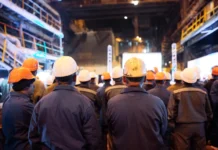by Dianna Brodine, vice president, editorial, Plastics Business
Business forecasting and strategic planning are activities undertaken by plastics manufacturing companies to prepare for future growth, determine next steps and identify gaps in resources. For most industry-leading molders, these activities also include an element of disaster planning to prepare for short-term disruptions due to weather events or cyberattacks. But what happens to that careful planning when the “short-term disruption” continues for two years? What happens when the “disaster” changes form over that time period – from health and safety to sales order inconsistency to supply chain challenges?
In March of 2020, US manufacturing companies experienced a wide range of reactions to the COVID-19 pandemic. Some companies were declared “essential” because of the products being produced – typically those related to medical markets. Others shut down or experienced significant drops in incoming orders, whether attributed to location (i.e., state mandates) or end use (i.e., automotive). Employee safety took on new meaning as plants scrambled to build barriers between stations and implement screening protocols.
As the months passed and solutions for some of these challenges were developed, new predicaments emerged. The talent crisis – already a focus of schools and manufacturing groups – encountered another test as the Great Resignation and early retirements led to an exodus from the workforce. The sales orders that had slowed or stopped suddenly roared back – often in higher quantities – and production schedules that had been slowed down needed to ramp up… quickly. The supply chain for the resins, components and equipment needed to meet the increased demand is unpredictable.
Plastics manufacturing businesses have been undergoing a two-year, involuntary stress test. And, while the challenges continue, there have been lessons learned that can be used in planning for and reacting to whatever might be coming next.
 Build a base of financial readiness
Build a base of financial readiness
“In the second quarter of 2020, we experienced a revenue drop of 60%, with an overall revenue drop of 23% for the year,” said Matt Fish, chief financial officer and an equity owner for Vital Plastics, an independently owned injection molding company with 230 employees. Located in Baldwin, Minnesota, the company operates two facilities and is a Tier 2 automotive supplier, with additional work in consumer goods, industrial goods, construction, electronics and non-cleanroom medical molding.
Vital Plastics’ revenue projections have bounced back – and continue to trend upward as 2022 begins, but the initial months of the pandemic demanded a quick response. “The president of our company is a former corporate banker and I’m a CPA, and our instinct was to protect our balance sheet,” said Fish. “We did a lot of things that felt like second nature to us.” This included contacting the bank and putting loans on deferment, suspending all major capital expenditures and shedding labor costs by cutting salaries for staff and laying off much of its employee base. “We cut and cut deep, because we didn’t know how long the pandemic would last,” he explained.
Jenn Barlund is president of Brookings, South Dakota-based Falcon Plastics, with 285 employees and four US locations. The company’s primary focus is injection molding, but it also provides blow molding and compression molding services, in addition to insert molding, decorating and product development. Barlund said the company immediately enacted a cash-based strategy when the pandemic hit US shores.
“Our two highest costs are labor and materials, so we reduced our inventories as much as possible,” she said, “and we added extra resources to stay on top of our customers and manage accounts receivable. We managed cash flow weekly, deferred capital purchases and pursued the Paycheck Protection Program (PPP) loan aggressively.” Falcon Plastics also implemented furloughs and layoffs for some of its team members and shut down one facility for six weeks. “We communicated with our employees every step of the way so they understood we were doing what had to be done to maintain the strength of the business so we could eventually bring them back to their jobs,” Barlund explained.
Falcon Plastics also took a step that likely was uncommon at a time when most businesses were leaning heavily on existing financial partners. “We took a look at our banking relationship and made a change,” Barlund said. “We analyzed it and looked at our options to make sure we had the best financial institute for the short- and long-term futures.”
 Be open and transparent in communications
Be open and transparent in communications
“We saw early on that transparency was going to be very important,” said Mark Murphy, president of Springville, Indiana’s PRD, Inc., a plastics injection molding company with 142 employees and a heavy concentration in automotive market, but also supplying consumer products, electronics and a grommet for ventilators during the COVID-19 surge. “After we had one of our first COVID-19 positive cases, we had feedback that employees felt we hadn’t communicated with them as quickly as they wished. Everyone was stressed out, there was a lot that was unknown, and we could have alleviated some of that by sharing what we knew.”
Murphy and others on the leadership team made it a priority to be accessible and visible on the floor, rather than communicating from behind a screen and through email. “The management team showed a lot of vulnerability throughout the conversations that happened after that situation, and we determined we were going to be fully transparent with everyone going forward.”
In addition to conversations related to employee health and safety, uncomfortable conversations were held when it became apparent that layoffs were necessary. However, Fish said, “Financial transparency was easy, because people understood the uncertainty in the economy. They didn’t question that cuts had to be made. We told them the industry was going to be making cars again – and at significant volume – so we would be able to bring them back. We told them we were making hard cuts now so we didn’t have to keep coming back and doing it again and again. We did everything we could to be open and honest.”
Internal communications with team members keep the presses running, but external conversations were needed too. Barlund said, “When everything hit in March of 2020, we started right away in communicating with our customers to get forecasts or order projections – anything we could find out about what their industries looked like. When we made salary cuts prior to layoffs and then when we had to make layoffs, we wanted to make sure we had the most visibility into our customers’ demand.” Because the Falcon Plastics’ sales team was grounded at that time, sales staff worked with the customer base to gather information on how the pandemic was expected to affect their businesses.
Fish echoed the increased need for customer conversations. “The frequency of communication with our customers has multiplied tenfold,” he said. “The key been in giving them constant updates – and that’s pretty much what all of our customers have told us: ‘We know it’s crazy, but keep us informed.’ ”
 Prepare for pricing volatility
Prepare for pricing volatility
Resin shortages have resulted in increased prices, and labor pressures have driven wage and benefit costs up far more quickly than expected. Plastics molding companies can’t maintain profitable margins if forced to absorb all of these costs, but customers are under their own pricing pressures. Contracts and culture play roles in the solutions.
“We’ve placed resin orders and the price has increased three times before the product showed up,” said Fish. “Nobody wants to have a pricing discussion, especially a buyer, so we’ve been pushing toward establishing contracts with all of our customers. A contract clearly states how we will handle material price increases.” Vital Plastics also reviewed its customer contracts and “tightened up” some of the language, given its experiences throughout the pandemic. “Pricing is a strategy, and everybody wins when there’s a contract because then you know how you’ve agreed to deal with an issue before it happens,” he continued.
Murphy said his company’s automotive customers typically require cost breakdowns in the event of resin price increases, but the number and frequency of cost increases and the part volume made that unreasonable in the current environment. “We produce hundreds of parts for many different customers, and we didn’t have time to have detailed discussions about each resin and the impact on each part cost,” he explained. “So, like a lot of our resin suppliers, we sent out an increase letter stating that, due to unforeseen events beyond our control, our customers needed to update their pricing lists. For those who pushed us for cost breakdowns, we were able to provide some samples to illustrate what we are seeing across the board. In the end, everyone was dealing with these increases on multiple fronts.”
Resins aren’t the only thing pushing part prices higher – significant wage increases have been enacted by many manufacturers to compete for employees.
“At Falcon Plastics, we saw this coming and started to build higher labor costs into our future quoting activities,” Barlund said. “In 2021, we implemented the largest wage increase we’ve ever seen as a corporation at all four of our locations, because we need to get good employees in and pay them appropriately, especially when we survey wages among other businesses in our area. We have to do what we can to protect our businesses so we can be there for our employees and our customers long term.”
Vital Plastics also increased wages, but Fish warned, “This wage war is a death spiral for everyone. Customers are only going to pay so much; yet they need to have a viable supplier. We’re building these increases into our quoting activities, but wages, benefits and inflation are going to continue to increase. How are we going to combat that?”
The answer may be in workplace culture. “Compensation is more than wages,” Fish continued. “We’ve got to be careful to think that a dollar more an hour will generate loyalty. As employers, we have to reflect about what is going to attract and retain employees.”
 Value the support team
Value the support team
In many ways, the definition of “community” has been changed – restricted by lockdowns or event cancellations and broadened through interactions on Zoom. Collaboration and knowledge-sharing have been critical as plastics molders work to solve these new challenges.
“As leaders, we like to think we have all the answers and have contingency plans for any situation, but I don’t think you can prepare for what we’ve been going through in the last two years,” said Murphy. “We relied on our management team and our employees to brainstorm policy changes and deal with COVID-19-related issues and concerns. The MAPP peer exchanges and our state and local chamber of commerce Zoom calls were invaluable, so we could hear what others were doing and implement what made sense for us. It’s been nice to know we’re not alone.”
Murphy and the leadership team at PRD, Inc. also tried to get to know each employee on a more personal level so they felt needed and appreciated throughout the stresses of the pandemic. “We relaxed some of our policies to give employees flexibility when they were late or absent. We’re also looking at hiring an employee advocate or chaplain to get more connected to our employees and support their needs. We’re trying to be flexible and react quickly.”
Building that family environment can pay unexpected dividends, and at Falcon Plastics that can mean a workforce that is deeply invested in the company’s success. “For those team members who are close to retirement, we’re trying to offer part-time or consulting work to help train that next generation of workers,” said Barlund. “We’re asking them to be part of their own succession plan – to train someone and pass their knowledge on before they step out. We have employees who have been here for 40+ years, and they don’t want to see Falcon fail.”
Fish quoted Mike Tyson when he said, “Everybody has a plan until they get punched in the mouth.”
He continued, “It’s great to have a plan, and we do – we actually have ‘pandemic’ in our disaster plan, but that doesn’t mean we were ready for everything that’s happened. In times of uncertainty, people are looking for a leader, but you don’t have to have all the answers. You’ve got to pull your team together and lean on them – to work together. Having plans is certainly important, but having a strong, engaged team around you is even more important, and I think I’ve learned the value of that team.
 Be ready to move quickly
Be ready to move quickly
“It’s so important in business to be able to flex,” said Barlund, “and flexing down is easy – it’s hard to do emotionally, but it’s easy to execute. Flexing up is really difficult.”
In 2020, Falcon Plastics, PRD and Vital Plastics – and manufacturing companies throughout the US – made difficult decisions, moving quickly to reduce costs and preserve assets. All three companies also experienced the roar of business returning – and the need to rapidly increase production capacity while still experiencing labor shortages and preserving cash flow.
“Agility is an important lesson to learn if you’re leading through a crisis,” Barlund added. “Our team needed to be equipped and prepared to make decisions quickly. Communication is what got us through.”





